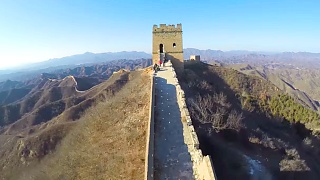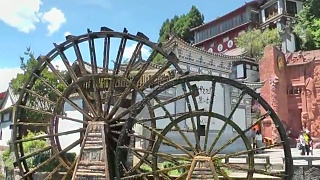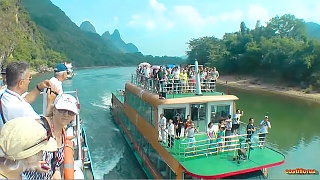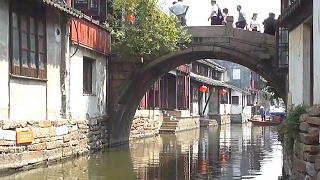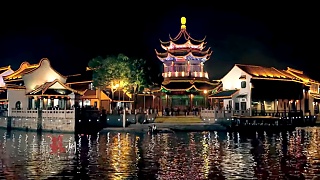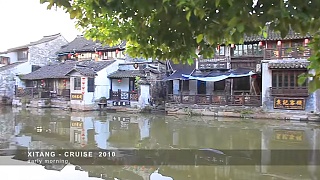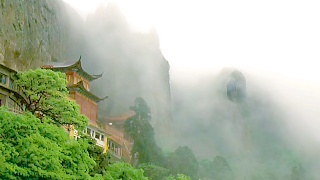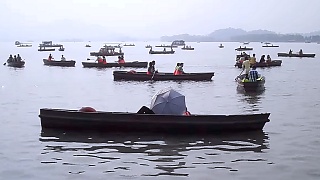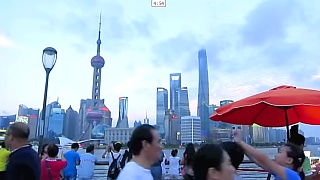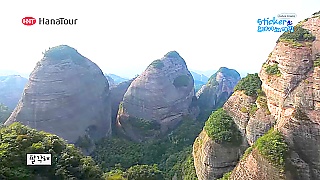
|
1. Calligraphy (书法, Shūfǎ)
Origin: Shang Dynasty
Ethnicity: Han
Chinese calligraphy, known as "shūfǎ" (书法) in Chinese, is the art of writing Chinese characters with brush and ink. This ancient craft has a long history in China and is highly regarded as a form of artistic expression. Calligraphy involves mastering various styles, such as seal script, clerical script, regular script, running script, and cursive script. Each style has its own unique characteristics and requires different techniques. Calligraphers practice for years to perfect their brush strokes, achieving balance, rhythm, and harmony in their work. Calligraphy is not only an art form but also a means of communication and a reflection of the writer's personality and emotions. It is often used to create beautiful works of art that adorn homes, temples, and public spaces, showcasing the cultural heritage and artistic traditions of the Chinese people.
2. Paper Cutting (剪纸, Jiǎnzhǐ)
Origin: Han Dynasty
Ethnicity: Han
Chinese paper cutting, known as "jiǎnzhǐ" (剪纸) in Chinese, is a traditional folk art that involves cutting intricate designs and patterns into paper. This ancient craft has been practiced in China for over a thousand years and is often used for decorative purposes during festivals and celebrations. The designs are typically created using red paper, which symbolizes good luck and happiness. Common motifs include flowers, animals, and scenes from folklore, each with its own symbolic meaning. Paper cutting requires precision and skill, as artisans use sharp scissors or knives to carefully cut the paper into delicate and intricate shapes. The finished pieces are often used to decorate windows, doors, and walls, adding a festive and artistic touch to the surroundings.
3. Porcelain (瓷器, Cíqì)
Origin: Tang Dynasty
Ethnicity: Han
Chinese porcelain, known as "cíqì" (瓷器) in Chinese, is a highly refined and durable type of ceramic that has been produced in China for over a thousand years. The art of making porcelain involves mixing kaolin clay with other minerals, shaping the mixture into desired forms, and firing it at high temperatures to create a hard, translucent material. Porcelain is often decorated with intricate designs and glazes, ranging from simple, elegant patterns to elaborate, colorful scenes. Famous styles of Chinese porcelain include blue and white porcelain, celadon, and famille rose. Chinese porcelain is highly prized for its beauty, craftsmanship, and historical significance, and it has been exported and admired worldwide for centuries.
4. Embroidery (刺绣, Cìxiù)
Origin: Han Dynasty
Ethnicity: Han, Miao, Zhuang
Chinese embroidery, known as "cìxiù" (刺绣) in Chinese, is a traditional textile art that involves stitching decorative patterns onto fabric using silk threads. This ancient craft has a rich history in China and is practiced by various ethnic groups, each with its own unique styles and techniques. Famous regional styles include Suzhou embroidery, known for its delicate and detailed work, and Miao embroidery, characterized by bold colors and geometric patterns. Embroidery is used to create beautiful clothing, accessories, and household items, often featuring intricate designs inspired by nature, mythology, and daily life. The craft requires precision, creativity, and a deep understanding of stitching techniques, reflecting the cultural heritage and artistic skills of the artisans.
5. Chinese Knots (中国结, Zhōngguó Jié)
Origin: Tang Dynasty
Ethnicity: Han
Chinese knotting, known as "zhōngguó jié" (中国结) in Chinese, is a decorative art form that involves tying intricate knots using silk or nylon cords. This ancient craft has a rich history in China and is often used to create decorative ornaments, accessories, and gifts. Chinese knots come in various shapes and designs, each with its own symbolic meaning. Common knot designs include the Pan Chang knot, which represents eternity, and the Double Coin knot, symbolizing wealth and prosperity. The craft requires patience, precision, and a thorough understanding of knotting techniques. Chinese knotting is often passed down through generations as a cultural tradition and is widely practiced during festivals, weddings, and other auspicious occasions.
6. Chinese Opera Masks (戏曲面具, Xìqǔ Miànjù)
Origin: Tang Dynasty
Ethnicity: Han
Chinese opera masks, known as "xìqǔ miànjù" (戏曲面具) in Chinese, are an essential element of traditional Chinese theater. These colorful masks are used to represent different characters and emotions in opera performances, allowing actors to convey their roles more vividly. Each mask design has its own unique characteristics and symbolism. Red masks symbolize loyalty and bravery, black masks represent integrity and righteousness, and white masks signify cunning and treachery. Chinese opera masks are typically made from materials such as paper-mâché, clay, or wood, and are intricately painted with bold, stylized designs. The masks help audiences distinguish between characters and understand their personalities and motivations, adding depth and drama to the performances.
7. Seal Carving (篆刻, Zhuànkè)
Origin: Shang Dynasty
Ethnicity: Han
Seal carving, known as "zhuànkè" (篆刻) in Chinese, is the art of engraving characters onto stone, metal, or wood to create seals, which are used for stamping documents and artwork. Seals are an important part of Chinese culture, often bearing the name of the owner or a meaningful phrase. The practice involves designing the seal, carving the characters in reverse, and polishing the surface for a smooth finish. Seal carving requires precision and skill, as the characters must be carved accurately and artistically. Seals are used by artists to sign their works and by individuals for official and personal purposes, reflecting their identity and status.
8. Bamboo Weaving (竹编, Zhúbiān)
Origin: Han Dynasty
Ethnicity: Han, Dai
Bamboo weaving, known as "zhúbiān" (竹编) in Chinese, is the art of creating functional and decorative items from bamboo strips, including baskets, mats, and furniture. The craft involves splitting bamboo into thin strips, which are then woven together using various techniques to form intricate patterns and shapes. Bamboo weaving is practiced in many regions of China, with each area developing its own unique styles and products. The Dai people, for example, are known for their colorful and durable bamboo baskets. This sustainable craft highlights the versatility of bamboo as a material and the skill of the artisans in transforming it into everyday objects.
9. Shadow Puppetry (皮影戏, Píyǐngxì)
Origin: Han Dynasty
Ethnicity: Han
Shadow puppetry, known as "píyǐngxì" (皮影戏) in Chinese, is a traditional Chinese form of storytelling using flat, articulated figures to create shadows on a screen. Performers manipulate the puppets behind the screen while narrating the story and providing voices for the characters. The puppets are typically made from leather or paper, intricately cut and painted to depict characters from folklore, mythology, and history. Shadow puppetry combines music, singing, and storytelling, creating a unique and immersive cultural experience. This art form has been recognized by UNESCO as an intangible cultural heritage, reflecting its importance in Chinese cultural traditions.
10. Blue and White Porcelain (青花瓷, Qīnghuācí)
Origin: Yuan Dynasty
Ethnicity: Han
Blue and white porcelain, known as "qīnghuācí" (青花瓷) in Chinese,
is a type of Chinese ceramic that features blue designs on a white background. This style of porcelain became popular during the Yuan Dynasty and reached its peak during the Ming and Qing Dynasties. The blue designs are created using cobalt oxide, which is applied to the surface of the porcelain before it is glazed and fired at high temperatures. Common motifs include floral patterns, landscapes, and scenes from Chinese folklore. Blue and white porcelain is highly prized for its beauty, craftsmanship, and historical significance, and it remains one of the most recognizable and admired forms of Chinese ceramics worldwide.
11. Silk Weaving (丝织, Sīzhī)
Origin: Han Dynasty
Ethnicity: Han
Silk weaving, known as "sīzhī" (丝织) in Chinese, is the process of creating luxurious textiles from silk threads. This ancient craft has been practiced in China for thousands of years and played a significant role in the country's history and economy. The process begins with raising silkworms to produce silk cocoons, which are then unwound to obtain silk threads. These threads are dyed and woven into intricate patterns using traditional looms. Silk weaving requires skill and precision, with artisans creating beautiful fabrics that are used for clothing, accessories, and home decor. The Silk Road, an ancient trade route, was named after this valuable textile, highlighting its importance in Chinese culture and global trade.
12. Peking Opera (京剧, Jīngjù)
Origin: Qing Dynasty
Ethnicity: Han
Peking Opera, known as "jīngjù" (京剧) in Chinese, is a traditional form of Chinese theater that combines music, singing, acting, and acrobatics. This art form originated in Beijing during the Qing Dynasty and has since become one of China's most famous cultural treasures. Peking Opera performances feature elaborate costumes, vibrant makeup, and stylized movements, with actors portraying historical, mythological, and fictional characters. The music is performed using traditional Chinese instruments, such as the jinghu (a two-stringed fiddle) and the pipa (a plucked lute). Peking Opera is known for its distinctive vocal style and complex choreography, requiring years of training for performers to master. It remains a beloved and influential part of Chinese cultural heritage.
13. Woodblock Printing (木版画, Mùbǎnhuà)
Origin: Tang Dynasty
Ethnicity: Han
Woodblock printing, known as "mùbǎnhuà" (木版画) in Chinese, is a traditional Chinese technique for printing text, images, and patterns using carved wooden blocks. This method was widely used for producing books, artworks, and textiles. The process involves carving the desired design into a wooden block, applying ink to the surface, and pressing it onto paper or fabric. Woodblock printing played a crucial role in the dissemination of knowledge and culture in ancient China. The prints often feature intricate details and vibrant colors, showcasing the skill and artistry of the craftsmen. This technique laid the foundation for modern printing methods and remains an important part of China's cultural heritage.
14. Paper Lanterns (纸灯笼, Zhǐdēnglóng)
Origin: Eastern Han Dynasty
Ethnicity: Han
Paper lanterns are traditional Chinese decorative items made from paper or silk, often used during festivals and celebrations. They come in various shapes and sizes, with designs ranging from simple to elaborate. The lanterns are typically illuminated by candles, oil lamps, or electric lights, creating a warm and festive atmosphere. Paper lanterns are especially popular during the Lantern Festival, which marks the end of the Chinese New Year celebrations. The craft involves constructing the lantern frame, covering it with paper or silk, and decorating it with paintings, calligraphy, or cut-outs. Paper lanterns symbolize good fortune, happiness, and the reunion of family.
15. Silver Ornaments (银饰, Yínshì)
Origin: Ming Dynasty
Ethnicity: Miao, Dong, Yao
Silver ornaments, known as "yínshì" (银饰) in Chinese, are traditional jewelry pieces crafted by ethnic minorities in China, such as the Miao, Dong, and Yao people. These ornaments include earrings, necklaces, bracelets, and headdresses, often featuring intricate designs and symbols. The craft involves techniques such as casting, hammering, engraving, and filigree to create detailed and delicate patterns. Silver ornaments are worn during festivals, weddings, and other important events, symbolizing beauty, wealth, and social status. They are also believed to have protective and auspicious properties. The craftsmanship of silver ornaments showcases the cultural heritage and artistic skills of these ethnic groups.
16. Tibetan Thangka Painting (唐卡, Tángkǎ)
Origin: 7th Century
Ethnicity: Tibetan
Thangka painting, known as "tángkǎ" (唐卡) in Chinese, is a traditional Tibetan art form that involves creating religious paintings on cloth, depicting Buddhist deities, mandalas, and scenes from scriptures. Thangkas are used for meditation, teaching, and as objects of veneration in monasteries and homes. The creation of a thangka involves meticulous drawing, painting, and sometimes embroidery, using natural pigments and gold. The process is highly ritualistic and requires a deep understanding of Buddhist iconography and symbolism. Thangka paintings are known for their vibrant colors, intricate details, and spiritual significance, reflecting the rich cultural and religious heritage of the Tibetan people.
17. Dragon Dance (舞龙, Wǔlóng)
Origin: Han Dynasty
Ethnicity: Han
The dragon dance, known as "wǔlóng" (舞龙) in Chinese, is a traditional Chinese performance that involves a team of dancers manipulating a large, flexible dragon puppet. The dance is typically performed during festivals such as Chinese New Year and the Lantern Festival to bring good luck and prosperity. The dragon, made of fabric and bamboo, can be over 30 meters long, with dancers using poles to animate its movements. The performance is accompanied by drums, gongs, and cymbals, creating a lively and festive atmosphere. The dragon dance symbolizes power, strength, and good fortune, reflecting the cultural importance of dragons in Chinese mythology.
18. Paper Fans (纸扇, Zhǐshàn)
Origin: Han Dynasty
Ethnicity: Han
Paper fans, known as "zhǐshàn" (纸扇) in Chinese, are traditional Chinese accessories made from paper or silk, mounted on bamboo or wooden frames. They are used for cooling, as well as for decorative and ceremonial purposes. Paper fans come in various shapes and sizes, with designs that often feature paintings, calligraphy, and poems. The craft involves constructing the fan frame, attaching the paper or silk, and decorating it with artistic elements. Paper fans are popular during festivals and as gifts, symbolizing elegance and cultural refinement. They are also used in traditional dance performances, adding grace and fluidity to the movements.
19. Yangko Dance (秧歌, Yānggē)
Origin: Song Dynasty
Ethnicity: Han
Yangko dance, known as "yānggē" (秧歌) in Chinese, is a traditional Chinese folk dance performed during festivals and celebrations, especially during the Lunar New Year. The dance is characterized by its lively and rhythmic movements, with dancers often carrying colorful fans or handkerchiefs. Yangko dance performances are typically accompanied by traditional music played on instruments such as drums, gongs, and flutes. The dance movements mimic agricultural activities and are meant to bring good harvests and prosperity. Yangko dance reflects the joyous spirit of the people and their connection to the land, showcasing the vibrancy and diversity of Chinese folk culture.
20. Chinese New Year Woodblock Prints (年画, Niánhuà)
Origin: Song Dynasty
Ethnicity
: Han
Chinese New Year woodblock prints, known as "niánhuà" (年画) in Chinese, are traditional folk art pieces created to celebrate the Lunar New Year. These prints depict auspicious symbols, deities, and scenes of prosperity and happiness, and are used to decorate homes and temples. The process involves carving the design into a wooden block, applying ink or paint, and pressing it onto paper. The prints are often brightly colored and feature intricate details. Niánhuà prints are believed to bring good luck and ward off evil spirits, reflecting the cultural significance and festive spirit of the Chinese New Year celebrations.
21. Kites (风筝, Fēngzhēng)
Origin: Han Dynasty
Ethnicity: Han
Kites, known as "fēngzhēng" (风筝) in Chinese, are traditional Chinese flying objects made from bamboo frames covered with paper or silk. Kites are used for recreational purposes, as well as for cultural and religious events. The craft of kite-making involves designing the frame, attaching the covering, and painting the kite with colorful patterns and motifs. Common designs include dragons, birds, and flowers. Kite flying is a popular activity during the Qingming Festival and other festivals, symbolizing the release of worries and the connection between the earthly and the divine. Chinese kites are admired for their beauty, craftsmanship, and cultural significance.
22. Chinese Puppetry (木偶戏, Mù'ǒuxì)
Origin: Han Dynasty
Ethnicity: Han
Chinese puppetry, known as "mù'ǒuxì" (木偶戏) in Chinese, is a traditional form of theater that uses puppets to tell stories and entertain audiences. Puppetry has a long history in China, with various regional styles and techniques. The puppets are typically made from wood, clay, or cloth, and are intricately crafted and painted. Performers manipulate the puppets using strings, rods, or their hands, bringing them to life with expressive movements and voices. Chinese puppetry often features stories from folklore, mythology, and history, combining music, singing, and dialogue to create engaging performances. This art form reflects the creativity and cultural heritage of the Chinese people.
23. Cloisonné (景泰蓝, Jǐngtàilán)
Origin: Yuan Dynasty
Ethnicity: Han
Cloisonné, known as "jǐngtàilán" (景泰蓝) in Chinese, is a traditional Chinese art form that involves decorating metal objects with enamel. The process begins by creating a design with thin metal wires, which are soldered onto a metal surface to form compartments (cloisons). These compartments are then filled with enamel paste and fired in a kiln. The enamel hardens into a glossy, colorful finish, and the piece is polished to reveal the intricate design. Cloisonné is used to create a variety of decorative items, including vases, bowls, and jewelry. This craft is admired for its beauty, complexity, and historical significance, reflecting the artistic achievements of Chinese artisans.
24. Dough Sculpture (面塑, Miànsù)
Origin: Tang Dynasty
Ethnicity: Han
Dough sculpture, known as "miànsù" (面塑) in Chinese, is a traditional folk art that involves shaping and molding colored dough into various shapes and figures. This art form originated in China during the Tang Dynasty and has since evolved into a popular form of decorative and ceremonial art. Dough sculptures are typically made from wheat or rice flour dough mixed with water and pigments to create vibrant colors. Artisans use their hands and simple tools to shape the dough into intricate designs, often depicting animals, mythological creatures, and scenes from daily life. Once the sculptures are completed, they are dried or baked to preserve them. Dough sculpture is often used to decorate temples, homes, and festive celebrations, adding a touch of color and whimsy to the surroundings.
25. Miao Embroidery (苗绣, Miáoxiù)
Origin: Ming Dynasty
Ethnicity: Miao
Miao embroidery, known as "miáoxiù" (苗绣) in Chinese, is a traditional textile art practiced by the Miao ethnic group. This craft involves stitching intricate patterns onto fabric using brightly colored threads. The designs often feature motifs inspired by nature, mythology, and daily life, reflecting the cultural heritage and artistic traditions of the Miao people. Miao embroidery is used to create clothing, accessories, and household items, often incorporating techniques such as cross-stitch, applique, and batik. The embroidery is highly detailed and vibrant, showcasing the skill and creativity of the artisans. Miao embroidery is an important cultural tradition, passed down through generations and celebrated for its beauty and craftsmanship.
26. Chinese Brush Painting (国画, Guóhuà)
Origin: Han Dynasty
Ethnicity: Han
Chinese brush painting, known as "guóhuà" (国画) in Chinese, is a traditional art form that uses brushes, ink, and pigments to create images on paper or silk. This painting style emphasizes the use of line, brushwork, and composition to convey the essence of the subject, rather than realistic details. Common themes include landscapes, flowers, birds, and figures, often accompanied by calligraphy and seals. Chinese brush painting requires mastery of various techniques, such as brush pressure, ink control, and composition. The art form reflects the philosophical and aesthetic principles of Chinese culture, emphasizing harmony, balance, and the beauty of nature.
27. Chinese Seal (印章, Yìnzhāng)
Origin: Shang Dynasty
Ethnicity: Han
The Chinese seal, known as "yìnzhāng" (印章) in Chinese, is a traditional tool used for stamping documents, artwork, and personal items. Seals are typically made from materials such as stone, metal, or wood, and are carved with characters or symbols representing the owner's name, title, or an auspicious phrase. The art of seal carving involves designing the seal, carving the characters in reverse, and polishing the surface for a smooth finish. Seals are an important part of Chinese culture, used by artists to sign their works and by individuals for official and personal purposes. The craft of seal carving requires precision and skill, reflecting the cultural and artistic heritage of China.
28. Chinese Tie-Dyeing (扎染, Zhārǎn)
Origin: Han Dynasty
Ethnicity: Bai, Yi
Chinese tie-dyeing, known as "zhārǎn" (扎染) in Chinese, is an ancient textile dyeing technique that involves tying or binding sections of fabric before dyeing to create patterns and designs. This art form has a long history in China and is practiced by various ethnic groups, including the Bai and Yi people. The process begins with preparing the fabric, which is typically made from natural materials such as cotton or silk. Artisans then use different tying and binding techniques to create intricate patterns, often inspired by nature, mythology, and traditional symbols. After tying, the fabric is submerged in dye baths, with each color applied in sequence. Once dyed, the fabric is washed and the ties are removed, revealing the intricate designs. Chinese tie-dyeing produces vibrant and unique textiles that are used for clothing, accessories, and decorative items, reflecting the rich cultural heritage and artistic creativity of the Chinese people.
29. Chinese Folk Painting (民间绘画, Mínjiān Huìhuà)
Origin: Han Dynasty
Ethnicity: Han
Chinese folk painting, known as "mínjiān huìhuà" (民间绘画) in Chinese, is a traditional art form that reflects the daily life, customs, and beliefs of the people. Folk paintings often feature vibrant colors and simple, expressive lines, depicting scenes from nature, mythology, and local festivals. The art form is practiced across various regions of China, with each area developing its own unique styles and themes. Folk paintings are commonly used to decorate homes, temples
, and public spaces, adding a touch of beauty and cultural significance to the surroundings. This art form embodies the creativity and spirit of the people, showcasing their connection to their heritage and community.
30. Chinese Paper-Cutting (剪纸, Jiǎnzhǐ)
Origin: Han Dynasty
Ethnicity: Han
Chinese paper-cutting, known as "jiǎnzhǐ" (剪纸) in Chinese, is a traditional folk art that involves cutting intricate designs into paper using scissors or knives. This craft has been practiced in China for over 1,500 years and is often associated with festivals, celebrations, and cultural rituals. Paper-cut designs range from simple to elaborate, featuring motifs such as animals, flowers, and auspicious symbols. The process involves folding the paper and cutting along specific lines to create symmetrical patterns. Paper-cuts are used to decorate windows, doors, and walls, adding a festive and artistic touch to homes and public spaces. This art form reflects the skill and creativity of the artisans, as well as the cultural values and traditions of Chinese society.
31. Tibetan Carpet Weaving (藏毯, Zàngtǎn)
Origin: 7th Century
Ethnicity: Tibetan
Tibetan carpet weaving, known as "zàngtǎn" (藏毯) in Chinese, is a traditional craft practiced by Tibetan people. This art form involves weaving carpets from wool, often featuring intricate patterns and vibrant colors inspired by nature, religion, and daily life. The weaving process begins with spinning and dyeing the wool, followed by setting up the loom and weaving the carpet by hand. Tibetan carpets are known for their durability, softness, and unique designs, reflecting the cultural and artistic heritage of the Tibetan people. These carpets are used for practical purposes, such as floor coverings and wall hangings, as well as for ceremonial and decorative purposes.
32. Chinese Opera Masks (戏曲面具, Xìqǔ Miànjù)
Origin: Song Dynasty
Ethnicity: Han
Chinese opera masks, known as "xìqǔ miànjù" (戏曲面具) in Chinese, are traditional masks used in various forms of Chinese opera. These masks are painted with vivid colors and patterns, representing different characters, emotions, and traits. The art of mask-making involves sculpting the mask from materials such as wood, paper-mache, or metal, and then painting it with intricate designs. Each color and pattern has specific meanings, with red symbolizing loyalty, black representing integrity, and white indicating treachery. Chinese opera masks are an essential part of the performance, enhancing the visual and emotional impact of the characters and stories. This craft reflects the rich cultural and artistic traditions of Chinese theater.
33. Yao Embroidery (瑶绣, Yáoxiù)
Origin: Tang Dynasty
Ethnicity: Yao
Yao embroidery, known as "yáoxiù" (瑶绣) in Chinese, is a traditional textile art practiced by the Yao ethnic group. This craft involves stitching intricate patterns onto fabric using brightly colored threads. The designs often feature motifs inspired by nature, mythology, and daily life, reflecting the cultural heritage and artistic traditions of the Yao people. Yao embroidery is used to create clothing, accessories, and household items, often incorporating techniques such as cross-stitch, applique, and batik. The embroidery is highly detailed and vibrant, showcasing the skill and creativity of the artisans. Yao embroidery is an important cultural tradition, passed down through generations and celebrated for its beauty and craftsmanship.
34. Nuo Opera (傩戏, Nuóxì)
Origin: Shang Dynasty
Ethnicity: Han
Nuo opera, known as "nuóxì" (傩戏) in Chinese, is a traditional form of Chinese theater that combines drama, music, dance, and acrobatics. This ancient art form originated during the Shang Dynasty and is closely associated with ritual and religious ceremonies. Nuo opera performances feature elaborate costumes, masks, and props, with actors portraying gods, spirits, and mythological figures. The stories often involve themes of good versus evil, exorcism, and blessings. Nuo opera is known for its dynamic and expressive style, requiring performers to master a range of skills. This art form reflects the deep cultural and spiritual heritage of the Chinese people, serving as a bridge between the human and the divine.
35. Chinese Shadow Puppetry (皮影戏, Píyǐngxì)
Origin: Han Dynasty
Ethnicity: Han
Chinese shadow puppetry, known as "píyǐngxì" (皮影戏) in Chinese, is a traditional form of storytelling that uses flat, articulated figures made from leather or paper to create shadows on a screen. This art form has been practiced in China for over a thousand years and is known for its intricate craftsmanship and expressive performances. The puppets are manipulated by skilled puppeteers using rods or strings, bringing the characters to life with movement and dialogue. Shadow puppetry performances often depict stories from folklore, mythology, and history, accompanied by music and singing. This craft reflects the creativity and cultural heritage of the Chinese people, providing a unique and captivating form of entertainment.
36. Suzhou Embroidery (苏绣, Sūxiù)
Origin: Han Dynasty
Ethnicity: Han
Suzhou embroidery, known as "sūxiù" (苏绣), is one of the most renowned embroidery styles in China. Originating in Suzhou, it is celebrated for its delicate and refined technique, using fine silk threads to create lifelike images. The art requires immense skill and patience, with artisans often spending months to complete a single piece. Suzhou embroidery often features landscapes, flowers, and birds, showcasing the natural beauty and artistic talent of the region.
37. Qiang Embroidery (羌绣, Qiāngxiù)
Origin: Qing Dynasty
Ethnicity: Qiang
Qiang embroidery, known as "qiāngxiù" (羌绣), is a traditional craft of the Qiang ethnic group. It is known for its bold colors and intricate patterns, often depicting geometric shapes, flowers, and animals. The embroidery is used to decorate clothing, accessories, and household items. Qiang embroidery reflects the rich cultural heritage and artistic expression of the Qiang people, with each piece telling a unique story.
38. Shu Embroidery (蜀绣, Shǔxiù)
Origin: Han Dynasty
Ethnicity: Han
Shu embroidery, known as "shǔxiù" (蜀绣), originates from Sichuan Province and is famous for its smooth and elegant style. It uses fine silk threads and a variety of stitching techniques to create detailed and vibrant images. Common themes include flowers, birds, and traditional Chinese symbols. Shu embroidery is highly valued for its artistic beauty and technical excellence, often used to create decorative items and gifts.
39. Chinese Knotting (中国结, Zhōngguó Jié)
Origin: Tang Dynasty
Ethnicity: Han
Chinese knotting, known as "zhōngguó jié" (中国结), is a traditional craft that involves creating decorative knots using a single piece of cord. Each knot has its own symbolic meaning, often representing good luck, prosperity, and longevity. The knots are used to create jewelry, ornaments, and home decorations. This craft requires precision and skill, with artisans using various techniques to create intricate and beautiful designs.
40. Dong Embroidery (侗绣, Dòngxiù)
Origin: Ming Dynasty
Ethnicity: Dong
Dong embroidery, known as "dòngxiù" (侗绣), is a traditional textile art of the Dong ethnic group. It is known for its vibrant colors and detailed patterns, often depicting scenes from nature, daily life, and Dong folklore. The embroidery is used to decorate clothing, accessories, and household items. Dong embroidery reflects the rich cultural heritage and artistic traditions of the Dong people, showcasing their connection to their environment and community.
41. Blue Calico Printing (蓝印花布, Lán Yìn Huā Bù)
Origin: Song Dynasty
Ethnicity: Han
Blue calico printing, known as "lán yìn huā bù" (蓝印花布), is a traditional Chinese textile art that involves printing patterns onto cotton fabric using indigo dye. The process involves creating a stencil, applying a resist paste, and dyeing the fabric. The result is a beautiful blue and white design, often featuring floral and geometric patterns. Blue calico is used for clothing, home decor, and ceremonial items, reflecting the cultural heritage and artistic creativity of Chinese artisans.
42. Paper Fan Making (扇子制作, Shànzi Zhìzuò)
Origin: Han Dynasty
Ethnicity: Han
Paper fan making, known as "shànzi zhìzuò" (扇子制作), is a traditional Chinese craft that involves creating beautiful and functional fans from paper and bamboo. The fans are often painted with calligraphy, landscapes, and floral designs. This craft requires precision and artistry, with each fan being a unique piece of art. Paper fans are used for cooling, decoration, and as cultural symbols in Chinese society.
43. Chinese Lantern Making (灯笼制作, Dēnglóng Zhìzuò)
Origin: Han Dynasty
Ethnicity: Han
Chinese lantern making, known as "dēnglóng zhìzuò" (灯笼制作), is a traditional craft that involves creating decorative lanterns from paper, silk, and bamboo. The lanterns are often brightly colored and feature intricate designs, symbolizing prosperity, good luck, and celebration. Lanterns are commonly used during festivals, such as the Lantern Festival and Chinese New Year, to add a festive and joyful atmosphere.
44. Tujia Brocade (土家织锦, Tǔjiā Zhījǐn)
Origin: Ming Dynasty
Ethnicity: Tujia
Tujia brocade, known as "tǔjiā zhījǐn" (土家织锦), is a traditional textile art of the Tujia ethnic group. It involves weaving colorful patterns and designs into fabric using silk and cotton threads. The brocade is known for its durability, bright colors, and intricate patterns, often depicting flowers, animals, and geometric shapes. Tujia brocade is used to create clothing, accessories, and home decor items, reflecting the cultural heritage and artistic traditions of the Tujia people.
45. Chinese Porcelain (瓷器, Cíqì)
Origin: Tang Dynasty
Ethnicity: Han
Chinese porcelain, known as "cíqì" (瓷器), is one of China's most famous and influential art forms. Porcelain involves shaping and firing clay at high temperatures to create durable and beautiful ceramic wares. The art of porcelain-making reached its peak during the Tang and Song Dynasties, with famous kilns such as Jingdezhen producing exquisite pieces. Chinese porcelain is admired for its delicate beauty, intricate designs, and technical excellence, often featuring blue-and-white patterns, floral motifs, and scenes from nature and mythology.
46. Hanfu Making (汉服制作, Hànfú Zhìzuò)
Origin: Han Dynasty
Ethnicity: Han
Hanfu making, known as "hànfú zhìzuò" (汉服制作), is the traditional craft of creating Han Chinese clothing. Hanfu refers to the historical clothing worn by the Han people, characterized by flowing robes, wide sleeves, and intricate patterns. The craft involves designing, cutting, and sewing fabric to create garments that reflect the elegance and cultural heritage of ancient China. Hanfu is experiencing a revival in modern times, with enthusiasts wearing it for cultural events, festivals, and daily life, celebrating Chinese history and identity.
47. Yixing Clay Teapots (宜兴紫砂壶, Y
íxìng Zǐshā Hú)
Origin: Ming Dynasty
Ethnicity: Han
Yixing clay teapots, known as "yíxìng zǐshā hú" (宜兴紫砂壶), are traditional Chinese teapots made from purple clay found in Yixing, Jiangsu Province. These teapots are prized for their unique ability to enhance the flavor of tea. The craft involves shaping the clay by hand or using molds, followed by firing at high temperatures. Yixing teapots are known for their unglazed surfaces, which allow the clay to absorb and release the aroma of the tea. They are highly collectible and valued for their beauty, functionality, and cultural significance.
48. Chinese Ruyi Scepter (如意, Rúyì)
Origin: Han Dynasty
Ethnicity: Han
The Chinese ruyi scepter, known as "rúyì" (如意), is a traditional symbol of power and good fortune. The scepter is often carved from materials such as jade, wood, or ivory, and features a curved shape with a cloud-like head. Ruyi scepters were used by scholars, officials, and emperors as a status symbol and a token of blessings. The name "ruyi" means "as you wish," reflecting its auspicious connotations. This craft combines artistry with cultural symbolism, representing authority, prosperity, and harmony.
49. Chinese Calligraphy (书法, Shūfǎ)
Origin: Shang Dynasty
Ethnicity: Han
Chinese calligraphy, known as "shūfǎ" (书法), is the artistic practice of writing Chinese characters with brush and ink. It is considered one of the highest forms of Chinese art, requiring skill, concentration, and creativity. Calligraphy involves writing characters in various styles, such as seal script, clerical script, cursive script, and regular script. Each style has its own rules and aesthetics. Calligraphy is not only a means of communication but also an expression of the writer's personality, emotions, and cultural identity. It is often displayed on scrolls, fans, and other mediums, admired for its beauty and artistic value.
50. Chinese Seal Engraving (篆刻, Zhuànkè)
Origin: Zhou Dynasty
Ethnicity: Han
Chinese seal engraving, known as "zhuànkè" (篆刻), is a traditional art form that involves carving characters into seals made of materials such as stone, ivory, or jade. Seals are used to imprint an individual's name or a decorative design on documents, artwork, and other items. The art of seal engraving requires precision and skill, with the engraver using specialized tools to create detailed and intricate designs. Seals are an important aspect of Chinese culture, symbolizing authority, authenticity, and personal identity.
51. Traditional Chinese Medicine (中医, Zhōngyī)
Origin: Han Dynasty
Ethnicity: Han
Traditional Chinese Medicine (TCM), known as "zhōngyī" (中医), is a holistic system of healthcare that has been practiced in China for thousands of years. TCM includes various therapies such as herbal medicine, acupuncture, cupping, and qigong. The principles of TCM are based on balancing the body's energy, known as "qi," and maintaining harmony between the body's internal organs and the external environment. TCM is deeply rooted in Chinese philosophy and culture, emphasizing the interconnectedness of the body, mind, and spirit.
52. Chinese Pottery (陶器, Táoqì)
Origin: Neolithic Era
Ethnicity: Han
Chinese pottery, known as "táoqì" (陶器), has a long and rich history, dating back to the Neolithic era. Pottery involves shaping and firing clay to create various vessels and objects, such as jars, bowls, and figurines. Chinese pottery is known for its diversity of styles, techniques, and glazes, with famous types including Tang sancai (three-colored) pottery and Cizhou ware. Pottery reflects the cultural and artistic achievements of different historical periods and regions in China, serving both practical and decorative purposes.
53. Naxi Dongba Painting (纳西东巴画, Nàxī Dōngbā Huà)
Origin: Yuan Dynasty
Ethnicity: Naxi
Naxi Dongba painting, known as "nàxī dōngbā huà" (纳西东巴画), is a traditional art form of the Naxi ethnic group in Yunnan Province. It involves creating religious and ceremonial paintings on paper or cloth, using natural pigments and simple brushes. Dongba paintings often depict deities, rituals, and symbols from Naxi mythology and culture. This art form is closely associated with the Dongba religion and its priests, who use the paintings in ceremonies and as teaching tools. Dongba painting reflects the spiritual and cultural heritage of the Naxi people, preserving their traditions and beliefs.
54. Chinese Sugar Painting (糖画, Táng Huà)
Origin: Ming Dynasty
Ethnicity: Han
Chinese sugar painting, known as "táng huà" (糖画), is a traditional folk art that involves creating intricate designs and figures using melted sugar. The artist uses a small ladle to pour and manipulate the sugar on a marble or metal surface, forming shapes such as animals, flowers, and symbols. Once the sugar cools and hardens, the delicate and edible artworks are ready to be enjoyed. Sugar painting is a popular attraction at Chinese festivals and fairs, delighting both children and adults with its sweet and artistic creations.
55. Chinese Cloisonné (景泰蓝, Jǐngtàilán)
Origin: Ming Dynasty
Ethnicity: Han
Chinese cloisonné, known as "jǐngtàilán" (景泰蓝), is a traditional enamelware craft that involves decorating metal objects with colorful enamel. The process includes creating a design with thin metal wires, filling the spaces with enamel paste, and firing the object to fuse the enamel to the metal. The result is a beautiful and durable piece with intricate patterns and vibrant colors. Cloisonné is used to create vases, bowls, jewelry, and decorative items, showcasing the artistry and technical skill of Chinese artisans.
56. Miao Silverwork (苗银, Miáoyín)
Origin: Ming Dynasty
Ethnicity: Miao
Miao silverwork, known as "miáoyín" (苗银), is a traditional craft of the Miao ethnic group, renowned for its intricate and beautiful silver jewelry. Miao silverwork includes necklaces, bracelets, earrings, and headdresses, often featuring detailed patterns and motifs inspired by nature and Miao mythology. The craft involves techniques such as hammering, engraving, and filigree work. Miao silver jewelry is not only a symbol of beauty and status but also an important aspect of cultural identity and heritage.
57. Tibetan Thangka Painting (唐卡, Tángkǎ)
Origin: 7th Century
Ethnicity: Tibetan
Tibetan Thangka painting, known as "tángkǎ" (唐卡), is a traditional form of Buddhist art that involves creating religious paintings on cloth or paper. Thangkas often depict deities, mandalas, and scenes from Buddhist mythology. The paintings are created using natural pigments and detailed brushwork, with the process requiring precision and devotion. Thangkas are used in religious ceremonies, meditation, and as teaching tools, reflecting the spiritual and artistic traditions of Tibetan Buddhism.
58. Chinese Gourd Painting (
葫芦画, Húlú Huà)
Origin: Qing Dynasty
Ethnicity: Han
Chinese gourd painting, known as "húlú huà" (葫芦画), is a folk art that involves decorating gourds with intricate designs and patterns. The process includes cleaning and drying the gourds, then using techniques such as painting, carving, and pyrography to create the artwork. Gourd paintings often feature themes from nature, folklore, and Chinese mythology. The decorated gourds are used as ornaments, containers, and symbolic gifts, representing good fortune and prosperity.
59. Chinese Jade Carving (玉雕, Yùdiāo)
Origin: Neolithic Era
Ethnicity: Han
Chinese jade carving, known as "yùdiāo" (玉雕), is an ancient and highly esteemed art form that involves sculpting jade into various objects and ornaments. Jade is prized for its beauty, durability, and symbolic significance, often associated with purity, longevity, and status. The carving process requires great skill and precision, with artisans creating intricate designs and detailed figures. Jade carvings include jewelry, figurines, seals, and ceremonial items, reflecting the cultural and artistic heritage of China.
60. Chinese Woodblock Printing (木刻版画, Mùkè Bǎnhuà)
Origin: Tang Dynasty
Ethnicity: Han
Chinese woodblock printing, known as "mùkè bǎnhuà" (木刻版画), is a traditional technique for printing text and images. The process involves carving a design into a wooden block, applying ink to the block, and pressing it onto paper or fabric. Woodblock printing was used to produce books, religious texts, and artworks, playing a significant role in the dissemination of knowledge and culture. The art form is admired for its detailed and expressive prints, showcasing the skill and creativity of Chinese artisans.
61. Chinese Opera Masks (戏曲脸谱, Xìqǔ Liǎnpǔ)
Origin: Yuan Dynasty
Ethnicity: Han
Chinese opera masks, known as "xìqǔ liǎnpǔ" (戏曲脸谱), are colorful and symbolic masks used in traditional Chinese opera performances. The masks are painted with intricate patterns and vibrant colors, each representing a specific character and their traits. Red symbolizes loyalty, black indicates integrity, and white suggests treachery. The art of creating and using opera masks is an important aspect of Chinese theatrical tradition, enhancing the visual and dramatic impact of performances.
62. Naxi Baisha Embroidery (白沙刺绣, Báishā Cìxiù)
Origin: Yuan Dynasty
Ethnicity: Naxi
Naxi Baisha embroidery, known as "báishā cìxiù" (白沙刺绣), is a traditional textile art of the Naxi ethnic group in Yunnan Province. It involves creating detailed and colorful embroidery on cloth, often depicting flowers, animals, and scenes from Naxi mythology. The embroidery is used to decorate clothing, accessories, and household items. Baisha embroidery reflects the rich cultural heritage and artistic traditions of the Naxi people, showcasing their connection to their environment and community.
63. Chinese Brush Making (毛笔制作, Máobǐ Zhìzuò)
Origin: Han Dynasty
Ethnicity: Han
Chinese brush making, known as "máobǐ zhìzuò" (毛笔制作), is a traditional craft that involves creating brushes for calligraphy and painting. The process includes selecting and preparing animal hair for the brush tip and crafting the handle from bamboo or wood. The quality of the brush is crucial for achieving the desired artistic effects in calligraphy and painting. Brush making requires skill and precision, with artisans carefully assembling and shaping each brush to meet specific artistic needs.
64. Tibetan Carpet Weaving (藏毯编织, Zàngtǎn Biānzhī)
Origin: 7th Century
Ethnicity: Tibetan
Tibetan carpet weaving, known as "zàngtǎn biānzhī" (藏毯编织), is a traditional craft of the Tibetan people, known for its colorful and durable woolen carpets. The carpets feature intricate patterns and designs inspired by Tibetan culture, nature, and Buddhism. Weaving involves hand-knotting or weaving wool threads onto a loom, creating thick and soft carpets. Tibetan carpets are used for home decor, ceremonial purposes, and as cultural symbols, reflecting the artistic heritage and craftsmanship of the Tibetan people.
65. Chinese Paper Cut (剪纸, Jiǎnzhǐ)
Origin: Han Dynasty
Ethnicity: Han
Chinese paper cutting, known as "jiǎnzhǐ" (剪纸), is a folk art that involves cutting intricate designs into paper. The art form is often used to create decorations for festivals, weddings, and other celebrations. Common themes include animals, flowers, and traditional symbols. Paper cuts are typically created using red paper, symbolizing good luck and happiness. This craft requires precision and creativity, with each piece being a unique work of art that reflects Chinese cultural values and traditions.
66. Chinese Seal Paste (印泥, Yìnní)
Origin: Tang Dynasty
Ethnicity: Han
Chinese seal paste, known as "yìnní" (印泥), is a traditional medium used with seals to create imprints. The paste is made from finely ground cinnabar, combined with castor oil and silk strands. The result is a thick, smooth paste that produces a vivid red impression. Seal paste is used in calligraphy, painting, and official documents, adding authenticity and artistic value. The craft of making seal paste requires knowledge of traditional techniques and materials, ensuring the quality and longevity of the paste.
67. Han Chinese Furniture (汉式家具, Hànshì Jiājù)
Origin: Tang Dynasty
Ethnicity: Han
Han Chinese furniture, known as "hànshì jiājù" (汉式家具), represents the traditional styles and craftsmanship of Chinese furniture-making. It includes items such as chairs, tables, cabinets, and beds, characterized by their elegant designs, quality materials, and intricate carvings. The furniture often features motifs inspired by nature, mythology, and Chinese culture. Han Chinese furniture reflects the aesthetic principles of balance, harmony, and simplicity, combining functionality with artistic beauty.
68. Chinese Embroidered Shoes (绣花鞋, Xiùhuā Xié)
Origin: Song Dynasty
Ethnicity: Han
Chinese embroidered shoes, known as "xiùhuā xié" (绣花鞋), are traditional footwear decorated with intricate embroidery. The shoes are often made from silk or cotton and feature floral, animal, and symbolic designs. Embroidered shoes were historically worn by women and children, symbolizing beauty, elegance, and cultural identity. The craft involves skilled embroidery techniques, with each pair of shoes being a unique and artistic creation that reflects Chinese fashion and heritage.
69. Chinese Shadow Puppetry (皮影戏, Píyǐngxì)
Origin: Han Dynasty
Ethnicity: Han
Chinese shadow puppetry, known as "píyǐngxì" (皮影戏), is a traditional form of entertainment that involves manipulating flat puppets made from leather or paper to create shadow images on a screen. The puppets are controlled by rods, and the performances are accompanied by music, narration, and singing. Shadow puppetry tells stories from Chinese
folklore, history, and mythology, combining visual art, storytelling, and performance. This craft requires skill in puppet-making, manipulation, and theatrical presentation, preserving an important aspect of Chinese cultural heritage.
70. Chinese Dough Figurines (面人, Miànrén)
Origin: Han Dynasty
Ethnicity: Han
Chinese dough figurines, known as "miànrén" (面人), are traditional folk art creations made from colored dough. Artisans shape the dough into various figures, such as animals, characters from folklore, and mythical beings. The process involves mixing flour with water and adding natural pigments to create vibrant colors. Dough figurines are popular at festivals and fairs, delighting audiences with their intricate details and imaginative designs. This craft combines artistic skill with cultural storytelling, preserving a unique aspect of Chinese folk art.
71. Chinese Porcelain (瓷器, Cíqì)
Origin: Tang Dynasty
Ethnicity: Han
Chinese porcelain, known as "cíqì" (瓷器), is a highly esteemed type of ceramic ware that originated in China. It is made from a fine, white clay called kaolin and fired at high temperatures to achieve a smooth, glass-like finish. Chinese porcelain is known for its beauty, durability, and artistic designs, featuring intricate patterns and glazes. Famous types of Chinese porcelain include blue-and-white ware, celadon, and famille rose. Porcelain has been an important cultural and economic export, symbolizing Chinese craftsmanship and artistic excellence.
72. Tibetan Metal Craft (藏族金属工艺, Zàngzú Jīnshǔ Gōngyì)
Origin: 7th Century
Ethnicity: Tibetan
Tibetan metal craft, known as "zàngzú jīnshǔ gōngyì" (藏族金属工艺), is a traditional art form that involves creating objects from metals such as gold, silver, and copper. Tibetan metal artisans produce items such as jewelry, religious artifacts, and household utensils, often featuring intricate designs and symbolic motifs. The craft combines techniques like casting, hammering, and engraving, showcasing the skill and creativity of Tibetan metalworkers. Tibetan metal craft reflects the cultural and spiritual heritage of the Tibetan people, with many pieces used in religious and ceremonial contexts.
73. Chinese Ceramic Sculptures (陶瓷雕塑, Táocí Diāosù)
Origin: Neolithic Era
Ethnicity: Han
Chinese ceramic sculptures, known as "táocí diāosù" (陶瓷雕塑), are traditional art forms that involve sculpting clay into various figures and objects, then firing them at high temperatures to create durable and artistic pieces. These sculptures include figurines, animals, and decorative items, often featuring detailed and expressive designs. Chinese ceramic sculptures have been produced for thousands of years, reflecting the cultural, religious, and artistic achievements of different historical periods and regions in China.
74. Chinese Lacquerware (漆器, Qīqì)
Origin: Neolithic Era
Ethnicity: Han
Chinese lacquerware, known as "qīqì" (漆器), is a traditional craft that involves coating objects with layers of lacquer to create a smooth, glossy finish. The process includes applying and polishing multiple layers of lacquer, often adding decorative elements such as inlays, carvings, and paintings. Lacquerware is used to make items such as boxes, trays, furniture, and accessories, valued for their beauty and durability. This craft combines artistic skill with technical expertise, showcasing the rich cultural heritage of Chinese lacquer artisans.
75. Chinese Bamboo Weaving (竹编, Zhúbiān)
Origin: Han Dynasty
Ethnicity: Han
Chinese bamboo weaving, known as "zhúbiān" (竹编), is a traditional craft that involves creating various objects by weaving thin strips of bamboo. The craft includes making items such as baskets, mats, hats, and furniture, often featuring intricate patterns and designs. Bamboo weaving requires skill and precision, with artisans carefully selecting and preparing the bamboo before weaving it into the desired shape. This craft reflects the resourcefulness and creativity of Chinese artisans, utilizing natural materials to create functional and artistic products.
76. Tibetan Sand Mandala (沙坛城, Shā Tánchéng)
Origin: 8th Century
Ethnicity: Tibetan
The Tibetan sand mandala, known as "shā tánchéng" (沙坛城), is a traditional form of Buddhist art that involves creating intricate designs with colored sand. Monks meticulously place grains of sand to form patterns and symbols representing the universe, deities, and spiritual concepts. The creation of a sand mandala is a meditative and ritualistic process, often taking days or weeks to complete. Once finished, the mandala is ceremonially destroyed to symbolize the impermanence of life. This craft combines artistic skill with spiritual practice, reflecting the deep cultural and religious traditions of Tibetan Buddhism.
77. Uyghur Dutar Making (都塔尔制作, Dūtǎěr Zhìzuò)
Origin: Tang Dynasty
Ethnicity: Uyghur
Uyghur dutar making, known as "dūtǎěr zhìzuò" (都塔尔制作), is a traditional craft of the Uyghur ethnic group, involving the creation of the dutar, a two-stringed musical instrument. The dutar is made from wood, with a long neck and a pear-shaped body. The strings are traditionally made from gut, although modern versions may use nylon or metal strings. The making of a dutar involves woodworking, carving, and stringing, with artisans often adding decorative elements such as inlays and carvings. The dutar is an important part of Uyghur music and culture, used in folk songs, dances, and celebrations.
78. Chinese Paper Cutting (剪纸, Jiǎnzhǐ)
Origin: Han Dynasty
Ethnicity: Han
Chinese paper cutting, known as "jiǎnzhǐ" (剪纸), is a traditional folk art that involves cutting intricate designs into paper. The art form is often used to create decorations for festivals, weddings, and other celebrations. Common themes include animals, flowers, and traditional symbols. Paper cuts are typically created using red paper, symbolizing good luck and happiness. This craft requires precision and creativity, with each piece being a unique work of art that reflects Chinese cultural values and traditions.
79. Dong Drum Tower Architecture (侗族鼓楼建筑, Dòngzú Gǔlóu Jiànzhù)
Origin: Song Dynasty
Ethnicity: Dong
Dong drum tower architecture, known as "dòngzú gǔlóu jiànzhù" (侗族鼓楼建筑), is a traditional architectural style of the Dong ethnic group, characterized by multi-story wooden towers. These drum towers serve as community centers and are often used for meetings, ceremonies, and cultural events. The architecture features intricate woodwork, with interlocking beams and columns that require no nails. The towers are decorated with carvings and paintings, reflecting Dong cultural themes and aesthetics. Dong drum towers are a symbol of community identity and cohesion, showcasing the craftsmanship and architectural knowledge of the Dong people.
80. Miao Batik (苗族蜡染, Miáozú Làrǎn)
Origin: Ming Dynasty
Ethnicity: Miao
Miao batik, known as "miáozú làrǎn" (苗族蜡染), is a traditional textile art of the Miao ethnic group, involving the use of wax and dye to create
intricate patterns on cloth. The process includes applying wax to the fabric to create resist areas, then dyeing the cloth, and finally removing the wax to reveal the design. Miao batik features motifs inspired by nature, mythology, and daily life, often in bold and contrasting colors. This craft requires skill and creativity, with each piece being a unique expression of Miao cultural heritage and artistic tradition.
81. Chinese Seal Carving (篆刻, Zhuànkè)
Origin: Zhou Dynasty
Ethnicity: Han
Chinese seal carving, known as "zhuànkè" (篆刻), is a traditional art form that involves carving characters and designs into seals, which are used to make imprints. The seals are typically made from materials such as stone, jade, or ivory, and are used in calligraphy, painting, and official documents. The process requires skill in carving and knowledge of ancient scripts and symbolism. Seal carving is a highly respected craft in Chinese culture, reflecting artistic expression and cultural heritage.
82. Uyghur Meshrep (麦西热甫, Màixīrèrèfǔ)
Origin: Tang Dynasty
Ethnicity: Uyghur
Uyghur meshrep, known as "màixīrèrèfǔ" (麦西热甫), is a traditional cultural and social gathering of the Uyghur people, involving music, dance, poetry, and storytelling. Meshrep events are held to celebrate important occasions, such as weddings, festivals, and community milestones. The gatherings are characterized by lively performances, communal meals, and social interaction, reflecting the values and traditions of Uyghur culture. Meshrep plays a vital role in preserving and transmitting cultural heritage, fostering community cohesion and cultural identity.
83. Chinese Kesi Weaving (缂丝, Kèsī)
Origin: Tang Dynasty
Ethnicity: Han
Chinese kesi weaving, known as "kèsī" (缂丝), is a traditional textile art that involves weaving intricate patterns and designs with silk threads. The process includes setting up a loom, creating a design, and meticulously weaving the silk to create detailed and vibrant images. Kesi weaving is known for its fine texture and rich colors, often depicting scenes from nature, mythology, and traditional Chinese culture. This craft requires great skill and patience, with each piece being a masterpiece of textile artistry.
84. Chinese Rattan Weaving (藤编, Téngbiān)
Origin: Han Dynasty
Ethnicity: Han
Chinese rattan weaving, known as "téngbiān" (藤编), is a traditional craft that involves creating various objects by weaving thin strips of rattan. The craft includes making items such as baskets, furniture, and decorative pieces, often featuring intricate patterns and designs. Rattan weaving requires skill and precision, with artisans carefully selecting and preparing the rattan before weaving it into the desired shape. This craft reflects the resourcefulness and creativity of Chinese artisans, utilizing natural materials to create functional and artistic products.
85. Tibetan Thangka Painting (唐卡绘画, Tángkǎ Huìhuà)
Origin: 7th Century
Ethnicity: Tibetan
Tibetan thangka painting, known as "tángkǎ huìhuà" (唐卡绘画), is a traditional form of Buddhist art that involves creating intricate and detailed paintings on cloth. Thangka paintings depict religious themes, such as deities, mandalas, and scenes from the life of the Buddha. The process includes preparing the cloth, sketching the design, and meticulously painting with natural pigments. Thangka paintings are used for meditation, teaching, and religious ceremonies, reflecting the spiritual and artistic heritage of Tibetan Buddhism. This craft requires artistic skill and devotion, with each piece being a sacred work of art.
86. Chinese Tofu Making (豆腐制作, Dòufǔ Zhìzuò)
Origin: Han Dynasty
Ethnicity: Han
Chinese tofu making, known as "dòufǔ zhìzuò" (豆腐制作), is a traditional culinary craft that involves creating tofu from soybeans. The process includes soaking and grinding the soybeans, boiling the mixture, and coagulating the soy milk to form curds, which are then pressed into blocks. Tofu is a versatile and nutritious food, used in a wide variety of dishes in Chinese cuisine. The craft of tofu making reflects the ingenuity and culinary heritage of Chinese food culture, with each region having its own variations and specialties.
87. Chinese Lantern Making (灯笼制作, Dēnglóng Zhìzuò)
Origin: Han Dynasty
Ethnicity: Han
Chinese lantern making, known as "dēnglóng zhìzuò" (灯笼制作), is a traditional craft that involves creating decorative lanterns from materials such as paper, silk, and bamboo. The process includes designing the lantern, constructing the frame, and adding decorative elements such as painting, calligraphy, and tassels. Lanterns are used for festivals, celebrations, and as decorative lighting, symbolizing light, hope, and happiness. This craft requires creativity and skill, with each lantern being a unique work of art that reflects Chinese cultural values and traditions.
88. Chinese Sugar Painting (糖画, Tánghuà)
Origin: Ming Dynasty
Ethnicity: Han
Chinese sugar painting, known as "tánghuà" (糖画), is a traditional folk art that involves creating intricate designs with melted sugar. The process includes heating sugar until it melts, then using a ladle or spoon to pour the sugar onto a surface to form patterns and shapes. Common themes include animals, flowers, and traditional symbols. Sugar paintings are popular at festivals and fairs, delighting audiences with their intricate details and sweetness. This craft requires skill and creativity, with each piece being a unique and ephemeral work of art that reflects Chinese folk culture.
89. Chinese Tea Processing (茶叶加工, Cháyè Jiāgōng)
Origin: Han Dynasty
Ethnicity: Han
Chinese tea processing, known as "cháyè jiāgōng" (茶叶加工), is a traditional craft that involves transforming freshly picked tea leaves into various types of tea. The process includes steps such as withering, rolling, oxidation, and drying, with different methods used to produce green tea, black tea, oolong tea, and other varieties. Tea processing requires knowledge of tea cultivation, processing techniques, and flavor profiles, ensuring the quality and distinctiveness of each type of tea. This craft reflects the rich cultural heritage and tradition of tea in Chinese society.
90. Chinese Tujia Brocade (土家族织锦, Tǔjiāzú Zhījǐn)
Origin: Han Dynasty
Ethnicity: Tujia
Chinese Tujia brocade, known as "tǔjiāzú zhījǐn" (土家族织锦), is a traditional textile art of the Tujia ethnic group, involving the creation of colorful and intricate woven fabrics. The process includes setting up a loom, designing the pattern, and weaving the threads to create detailed and vibrant textiles. Tujia brocade features motifs inspired by nature, folklore, and daily life, often in bold and contrasting colors. This craft requires skill and creativity, with each piece being a unique expression of Tujia cultural heritage and artistic tradition.
91. Chinese Dong Embroidery (侗族刺绣, Dòngzú Cìxiù)
Origin: Ming Dynasty
Ethnicity: Dong
Chinese Dong embroidery, known as "dòng
zú cìxiù" (侗族刺绣), is a traditional textile art of the Dong ethnic group, involving the creation of intricate and colorful embroidered designs. The process includes drawing the design on cloth, selecting threads, and stitching the patterns using various embroidery techniques. Dong embroidery features motifs inspired by nature, folklore, and cultural symbols, often in vibrant colors and intricate details. This craft requires skill and creativity, with each piece being a unique expression of Dong cultural heritage and artistic tradition.
92. Chinese Paper Folding (折纸, Zhēzhǐ)
Origin: Song Dynasty
Ethnicity: Han
Chinese paper folding, known as "zhézhǐ" (折纸), is a traditional folk art that involves folding paper into various shapes and figures. The art form is often used to create decorations, toys, and gifts, with common themes including animals, flowers, and traditional symbols. Paper folding requires skill and creativity, with each piece being a unique work of art that reflects Chinese cultural values and traditions. This craft combines artistic expression with technical skill, preserving an important aspect of Chinese folk culture.
93. Chinese Cloth Shoes Making (布鞋制作, Bùxié Zhìzuò)
Origin: Han Dynasty
Ethnicity: Han
Chinese cloth shoes making, known as "bùxié zhìzuò" (布鞋制作), is a traditional craft that involves creating shoes from cloth materials. The process includes designing the shoe pattern, cutting the fabric, sewing the pieces together, and adding decorative elements such as embroidery and appliqué. Cloth shoes are valued for their comfort, durability, and cultural significance, often worn during festivals and special occasions. This craft requires skill and creativity, with each pair of shoes being a unique work of art that reflects Chinese cultural heritage and craftsmanship.
94. Chinese Blue and White Porcelain (青花瓷, Qīnghuācí)
Origin: Yuan Dynasty
Ethnicity: Han
Chinese blue and white porcelain, known as "qīnghuācí" (青花瓷), is a highly esteemed type of ceramic ware that originated in China. It is characterized by its blue designs, often depicting landscapes, flowers, and traditional scenes, on a white background. The process includes forming the porcelain, applying the blue designs using cobalt oxide, and firing the piece at high temperatures. Blue and white porcelain is known for its beauty, durability, and artistic designs, symbolizing Chinese craftsmanship and artistic excellence.
95. Chinese Shadow Puppetry (皮影戏, Píyǐngxì)
Origin: Han Dynasty
Ethnicity: Han
Chinese shadow puppetry, known as "píyǐngxì" (皮影戏), is a traditional form of theater that involves manipulating flat, articulated puppets made from leather to create shadows on a screen. The puppets are controlled by rods, and their movements are synchronized with music, dialogue, and narration to tell stories. Shadow puppetry often features themes from folklore, history, and mythology, combining visual art, storytelling, and performance. This craft requires skill in puppet-making, manipulation, and theatrical presentation, preserving an important aspect of Chinese cultural heritage.
96. Chinese Dough Figurines (面人, Miànrén)
Origin: Han Dynasty
Ethnicity: Han
Chinese dough figurines, known as "miànrén" (面人), are traditional folk art creations made from colored dough. Artisans shape the dough into various figures, such as animals, characters from folklore, and mythical beings. The process involves mixing flour with water and adding natural pigments to create vibrant colors. Dough figurines are popular at festivals and fairs, delighting audiences with their intricate details and imaginative designs. This craft combines artistic skill with cultural storytelling, preserving a unique aspect of Chinese folk art.
97. Chinese Porcelain (瓷器, Cíqì)
Origin: Tang Dynasty
Ethnicity: Han
Chinese porcelain, known as "cíqì" (瓷器), is a highly esteemed type of ceramic ware that originated in China. It is made from a fine, white clay called kaolin and fired at high temperatures to achieve a smooth, glass-like finish. Chinese porcelain is known for its beauty, durability, and artistic designs, featuring intricate patterns and glazes. Famous types of Chinese porcelain include blue-and-white ware, celadon, and famille rose. Porcelain has been an important cultural and economic export, symbolizing Chinese craftsmanship and artistic excellence.
98. Tibetan Metal Craft (藏族金属工艺, Zàngzú Jīnshǔ Gōngyì)
Origin: 7th Century
Ethnicity: Tibetan
Tibetan metal craft, known as "zàngzú jīnshǔ gōngyì" (藏族金属工艺), is a traditional art form that involves creating objects from metals such as gold, silver, and copper. Tibetan metal artisans produce items such as jewelry, religious artifacts, and household utensils, often featuring intricate designs and symbolic motifs. The craft combines techniques like casting, hammering, and engraving, showcasing the skill and creativity of Tibetan metalworkers. Tibetan metal craft reflects the cultural and spiritual heritage of the Tibetan people, with many pieces used in religious and ceremonial contexts.
99. Chinese Ceramic Sculptures (陶瓷雕塑, Táocí Diāosù)
Origin: Neolithic Era
Ethnicity: Han
Chinese ceramic sculptures, known as "táocí diāosù" (陶瓷雕塑), are traditional art forms that involve sculpting clay into various figures and objects, then firing them at high temperatures to create durable and artistic pieces. These sculptures include figurines, animals, and decorative items, often featuring detailed and expressive designs. Chinese ceramic sculptures have been produced for thousands of years, reflecting the cultural, religious, and artistic achievements of different historical periods and regions in China.
100. Chinese Lacquerware (漆器, Qīqì)
Origin: Neolithic Era
Ethnicity: Han
Chinese lacquerware, known as "qīqì" (漆器), is a traditional craft that involves coating objects with layers of lacquer to create a smooth, glossy finish. The process includes applying and polishing multiple layers of lacquer, often adding decorative elements such as inlays, carvings, and paintings. Lacquerware is used to make items such as boxes, trays, furniture, and accessories, valued for their beauty and durability. This craft combines artistic skill with technical expertise, showcasing the rich cultural heritage of Chinese lacquer artisans.
101. Chinese Bamboo Weaving (竹编, Zhúbiān)
Origin: Han Dynasty
Ethnicity: Han
Chinese bamboo weaving, known as "zhúbiān" (竹编), is a traditional craft that involves creating various objects by weaving thin strips of bamboo. The craft includes making items such as baskets, mats, hats, and furniture, often featuring intricate patterns and designs. Bamboo weaving requires skill and precision, with artisans carefully selecting and preparing the bamboo before weaving it into the desired shape. This craft reflects the resourcefulness and creativity of Chinese artisans, utilizing natural materials to create functional and artistic products.
102. Tibetan Sand Mandala (沙坛城, Shā Tánchéng)
Origin: 8th Century
Ethnicity: Tibetan
The Tibetan sand mandala, known as "shā tánchéng" (沙坛城), is a traditional form of Buddhist art that involves creating intricate designs with colored sand. Monks meticulously place grains of sand to form patterns and symbols representing the universe, deities, and spiritual concepts. The process of creating a sand mandala is both a meditative practice and a symbolic representation of impermanence, as the mandala is often destroyed after completion. This craft requires patience, precision, and spiritual devotion, reflecting the rich cultural and religious heritage of Tibetan Buddhism.
103. Chinese Paper Making (造纸术, Zàozhǐshù)
Origin: Han Dynasty
Ethnicity: Han
Chinese paper making, known as "zàozhǐshù" (造纸术), is a traditional craft that involves creating paper from natural materials such as bamboo, hemp, and mulberry bark. The process includes pulping the raw materials, forming sheets of paper, and drying them. Chinese paper making is considered one of the Four Great Inventions of ancient China, revolutionizing communication and cultural transmission. This craft requires knowledge of materials and techniques, reflecting the ingenuity and cultural heritage of Chinese paper artisans.
104. Chinese Hair Embroidery (发绣, Fàxiù)
Origin: Tang Dynasty
Ethnicity: Han
Chinese hair embroidery, known as "fàxiù" (发绣), is a unique and intricate form of embroidery that uses human hair as the thread. The process includes preparing the hair, designing the pattern, and stitching the design onto fabric. Hair embroidery is known for its fine detail and realistic textures, often depicting portraits, landscapes, and cultural symbols. This craft requires great skill and patience, with each piece being a testament to the artistic and cultural heritage of Chinese embroidery artisans.
105. Chinese Ink Rubbing (拓片, Tàpiàn)
Origin: Tang Dynasty
Ethnicity: Han
Chinese ink rubbing, known as "tàpiàn" (拓片), is a traditional technique used to reproduce inscriptions and images from stone, metal, or wood surfaces onto paper. The process includes placing a sheet of paper over the carved surface, applying ink or pigment, and rubbing the paper to transfer the design. Ink rubbings are used to preserve historical inscriptions, calligraphy, and artwork, providing valuable records of cultural heritage. This craft requires skill in handling materials and techniques, reflecting the historical and cultural significance of Chinese ink rubbing.
106. Chinese Lacquer Carving (雕漆, Diāoqī)
Origin: Tang Dynasty
Ethnicity: Han
Chinese lacquer carving, known as "diāoqī" (雕漆), is a traditional craft that involves carving intricate designs into layers of lacquer applied to a surface. The process includes building up multiple layers of lacquer, carving the desired design, and polishing the finished piece. Lacquer carving is used to create decorative items such as boxes, trays, and furniture, known for their beauty and durability. This craft requires artistic skill and precision, reflecting the rich cultural heritage and artistic achievements of Chinese lacquer artisans.
107. Chinese Silverware (银器, Yínqì)
Origin: Han Dynasty
Ethnicity: Han
Chinese silverware, known as "yínqì" (银器), is a traditional craft that involves creating items from silver, such as jewelry, utensils, and decorative objects. The process includes casting, hammering, and engraving the silver to create intricate designs and patterns. Chinese silverware is known for its beauty and craftsmanship, often featuring motifs inspired by nature, mythology, and cultural symbols. This craft requires skill and creativity, reflecting the artistic and cultural heritage of Chinese silversmiths.
108. Chinese Shadow Play (皮影戏, Píyǐngxì)
Origin: Han Dynasty
Ethnicity: Han
Chinese shadow play, known as "píyǐngxì" (皮影戏), is a traditional form of theater that involves manipulating flat, articulated puppets made from leather to create shadows on a screen. The puppets are controlled by rods, and their movements are synchronized with music, dialogue, and narration to tell stories. Shadow play often features themes from folklore, history, and mythology, combining visual art, storytelling, and performance. This craft requires skill in puppet-making, manipulation, and theatrical presentation, preserving an important aspect of Chinese cultural heritage.
|

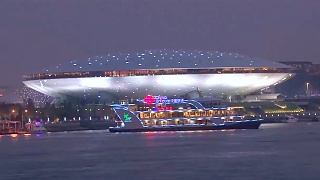





 The beautiful NanXun ancient water town, ZheJiang province
The beautiful NanXun ancient water town, ZheJiang province




